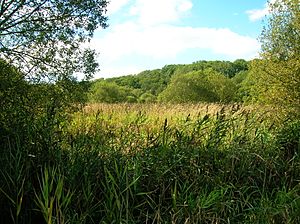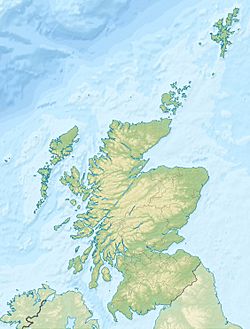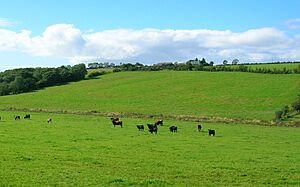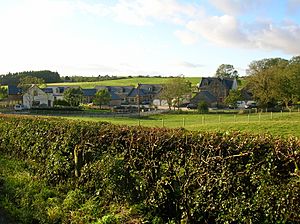Lindston Loch, South Ayrshire facts for kids
Quick facts for kids Lindston Loch |
|
|---|---|

The site of Lindston Loch
|
|
| Location | Dalrymple, South Ayrshire, Scotland |
| Coordinates | 55°24′48″N 4°34′22″W / 55.413425°N 4.572797°W |
| Type | Freshwater loch |
| Primary inflows | Direct rainfall, runoff, plus the Balsarroch and Boghall Burns |
| Primary outflows | Dustyhall Burn that joins the Purclewan Burn. |
| Basin countries | Scotland |
| Max. length | 200 yards (180 m) |
| Max. width | 100 yards (91 m) |
| Surface area | 2.78 acres (1.13 ha) |
| Average depth | Shallow |
| Settlements | Dalrymple |
Lindston Loch was a small freshwater lake in Scotland. It was located in a special type of dip in the ground called a 'kettle hole.' This area is in South Ayrshire, near the village of Dalrymple.
Contents
About Lindston Loch
Maps from the 1870s show what Lindston Loch looked like. It was about 180 meters (200 yards) long and 90 meters (100 yards) wide. The loch was shaped like an oval. It covered an area of about 1.125 hectares (2.78 acres).
A part of the loch in the southwest had been filled in. This might have been done with waste from old quarries nearby. Streams from places like Boghall and Balsarroch helped to fill the loch with water.
Why the Loch Was Drained
People started draining the loch, or making it smaller, a long time ago. This might have begun in the 1700s. Important landowners, like Alexander Montgomerie, the 10th Earl of Eglinton, wanted to improve their farms. Other landowners followed his lead.
Some draining work might have happened in the 1740s. This was done to give jobs to Irish workers during times of famine. Many draining projects also took place after World War I. This was when many soldiers came home and needed work.
How People Used the Loch
Water from the loch used to flow into the Dustyhall Burn. This burn then joined the Purclewan Burn. The Purclewan Burn helped power a mill at Burnton. Records show that draining work was done in 1790.
People also used the loch for fun. Curling matches were played on the ice in winter. There are records of games on January 15, 1850, and December 19, 1844. A special area for curling was still noted on maps in the late 1890s.
Ancient Discoveries at Lindston Loch
In 1790, an old bronze jug was found in Lindston Loch. It was about 24 cm (9.6 inches) tall. This jug had a spout and a handle. Experts believe it was made in the late Middle Ages. For many years, it was kept at the Dalrymple Manse, which is a minister's house.
Another very similar bronze jug was found nearby at Skeldon. This shows that these types of items were used in the area.
An old Roman road passed close to Lindston Loch. This road connected the Solway Firth and the Clyde River. The bronze jug was found near this road. In 1833, a glazed pottery pitcher was also found near the old road at Perclewan. This pitcher had a man's face and hands on it.
Lindston Camp
Above the loch, there was a place called Lindston Camp. It was on a flat hilltop about 120 meters (400 feet) above sea level. This camp had a circular ditch around it. The ditch was about 6.4 meters (21 feet) wide and 0.6 to 0.9 meters (2 or 3 feet) deep. It was filled with weedy water.
Inside the ditch, there was a circular space about 40 meters (130 feet) across. This area barely rose above the ground around it. There was no sign of a rampart, which is a defensive wall. This earthwork might have been a henge, a type of ancient monument. It offered amazing views in all directions. The entrance to the camp was on the east side. A path about 7 meters (23 feet) wide crossed the ditch there.
What Lindston Means
The name "Lindston" might come from the word "Lind." In Scots, "Lind" means a Lime tree or Linden tree. It could also mean a general area of woodland. So, the name "Lindston" likely means a 'rocky place within a forest.'
Nature at the Loch Site
In 1846, the loch was full of fish like pike, perch, and eels. Many wild birds also visited, including wild-duck, teal, and widgeon.
Today, a large woodland grows towards Lindston Farm. There are also big areas of reeds, which are tall grass-like plants. The site of the loch is recognized as an important wildlife area in South Ayrshire. Maps from the 1870s show a forest below Lindston Farm. Now, many willow bushes have grown there too.
Robert Burns and Nelly Kilpatrick
When the famous Scottish poet Robert Burns was 15, he met his first love. Her name was Nelly Bone, but she was known as Nelly Kilpatrick in this part of Ayrshire. Nelly's father was the miller in the small village of Purclewan.
Robert and Nelly met when Robert's father, William Burns, hired extra help for the harvest. This was when they lived at Mount Oliphant Farm. Robert wrote his first song, "Handsome Nell," with Nelly in mind:
"O once I lov'd a bonnie lass, Aye, and I love her still; And whilst that virtue warms my breast, I'll love my handsome Nell."
Years later, Burns wrote about this song. He said he never thought about being a poet until he fell deeply in love. Then, writing poems and songs felt natural to him. He remembered composing "Handsome Nell" with strong feelings. He said that even years later, thinking about it made his heart melt.
Images for kids






